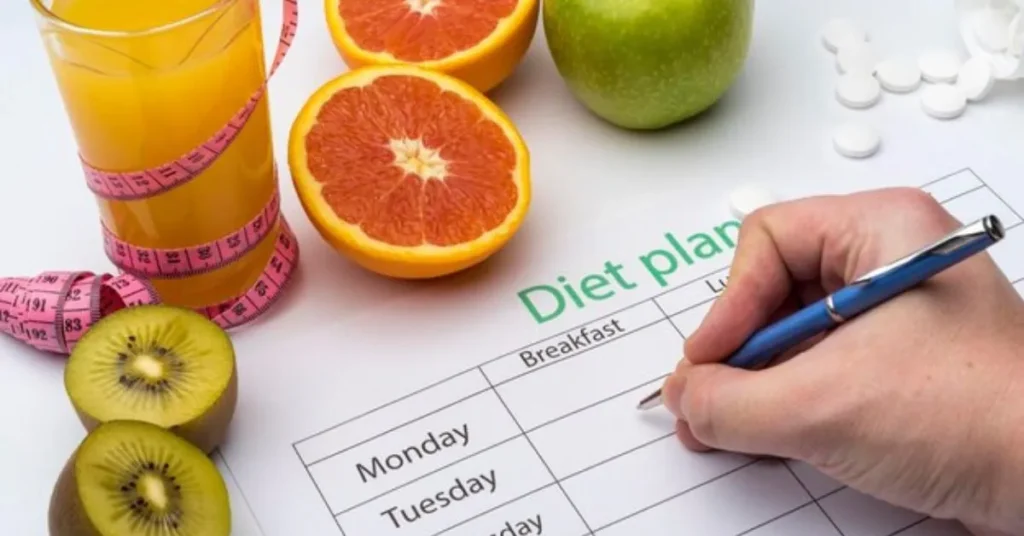How to Choose a Daily Diet to Lose Body Fat, losing body fat is a common goal for many people aiming to improve their health and appearance. However, with an overwhelming amount of information available, it can be challenging to determine the most effective and sustainable way to achieve this goal. This article will guide you through the process of choosing a daily diet that promotes fat loss, addressing common questions, and providing practical tips to create a personalized diet plan.
Understanding the Basics of Fat Loss
Before diving into specific diets and strategies, it’s essential to understand the fundamental principle of fat loss: creating a calorie deficit. A calorie deficit occurs when you consume fewer calories than your body needs to maintain its current weight, forcing it to utilize stored fat for energy. This principle is the foundation of all effective fat loss diets.
The Role of Macronutrients
Macronutrients, which include carbohydrates, proteins, and fats, play a significant role in your diet and can impact fat loss. Here’s a brief overview of each:
- Carbohydrates: Provide energy and are found in foods like grains, fruits, vegetables, and legumes. Opt for complex carbs like whole grains and vegetables over simple sugars for sustained energy and better satiety.
- Proteins: Essential for muscle repair and growth, proteins help maintain muscle mass during weight loss. Sources include meat, fish, dairy, beans, and nuts.
- Fats: Necessary for hormone production and nutrient absorption. Choose healthy fats from sources like avocados, nuts, seeds, and olive oil.
Importance of Micronutrients
Micronutrients, including vitamins and minerals, are crucial for overall health and can affect your metabolism and energy levels. Ensure your diet includes a variety of fruits, vegetables, and other nutrient-dense foods to meet your micronutrient needs.
Choosing the Right Diet for Fat Loss
There is no one-size-fits-all diet for fat loss. The best diet is one that you can stick to long-term and that suits your lifestyle and preferences. Here are some popular diet approaches:
1. Balanced Diet
A balanced diet includes a variety of foods from all food groups in appropriate proportions. This approach focuses on whole, minimally processed foods and emphasizes portion control. It can be easier to maintain and can provide all the necessary nutrients for good health.
2. Low-Carb Diet
Low-carb diets, such as the ketogenic diet, restrict carbohydrate intake and increase fat and protein consumption. These diets can help reduce hunger and stabilize blood sugar levels, making it easier to maintain a calorie deficit. However, they may not be suitable for everyone, especially those who engage in high-intensity exercise.
3. Mediterranean Diet
The Mediterranean diet emphasizes fruits, vegetables, whole grains, lean proteins (especially fish), and healthy fats like olive oil. It has been shown to promote weight loss and improve overall health due to its focus on nutrient-dense, anti-inflammatory foods.
4. Intermittent Fasting
Intermittent fasting involves cycling between periods of eating and fasting. Common methods include the 16/8 method (fasting for 16 hours and eating during an 8-hour window) and the 5:2 method (eating normally for five days and restricting calories for two non-consecutive days). This approach can help reduce calorie intake and improve metabolic health.
The 30-30-30 Rule for Weight Loss
The 30-30-30 rule is a simple guideline to help structure your diet and exercise routine for fat loss:
- 30% of Calories from Protein: Ensuring that 30% of your daily calorie intake comes from protein can help preserve muscle mass, increase satiety, and boost metabolism.
- 30 Minutes of Exercise: Engaging in at least 30 minutes of moderate-intensity exercise daily can help burn calories and improve overall fitness.
- 30 Minutes of Movement: In addition to structured exercise, aim for an additional 30 minutes of general movement, such as walking, taking the stairs, or doing household chores, to increase your overall activity level.
How to Choose Your Diet to Lose Weight
Choosing the right diet involves considering your lifestyle, preferences, and nutritional needs. Here are some steps to help you make an informed decision:
1. Assess Your Current Diet
Start by tracking your current food intake for a few days to identify eating patterns and areas for improvement. Use a food diary or a mobile app to record everything you eat and drink.
2. Set Realistic Goals
Define clear, achievable goals for your fat loss journey. Instead of aiming for rapid weight loss, focus on gradual, sustainable changes. Aiming to lose 1-2 pounds per week is generally considered safe and realistic.
3. Consider Your Preferences
Choose a diet that includes foods you enjoy and can see yourself eating long-term. Restrictive diets that eliminate entire food groups or require you to eat foods you dislike are harder to maintain and may lead to nutritional deficiencies.
4. Plan for Flexibility
Allow for some flexibility in your diet to accommodate social events, cravings, and unexpected situations. Adopting a flexible approach can help you stay on track without feeling deprived.
5. Seek Professional Guidance
Consulting a registered dietitian or nutritionist can provide personalized advice and help you create a balanced, effective diet plan tailored to your needs and goals.
Creating a Diet Plan for Fat Loss
A well-structured diet plan can make it easier to achieve and maintain a calorie deficit. Here are some tips to help you create an effective plan:
1. Calculate Your Caloric Needs
Determine your daily caloric needs using an online calculator that factors in your age, gender, weight, height, and activity level. To lose weight, aim for a daily calorie intake that is 500-1000 calories less than your maintenance level, which should result in a weight loss of about 1-2 pounds per week.
2. Distribute Your Macronutrients
Based on your caloric needs, distribute your calories among carbohydrates, proteins, and fats. A common macronutrient distribution for fat loss is 40% carbs, 30% protein, and 30% fats, but this can be adjusted based on your preferences and dietary approach.
3. Plan Balanced Meals
Ensure each meal includes a source of protein, healthy fats, and fiber-rich carbohydrates. This balance can help control hunger, stabilize blood sugar levels, and provide sustained energy.
4. Prepare Healthy Snacks
Having healthy snacks on hand can prevent overeating during meals and help control cravings. Choose snacks that combine protein and fiber, such as Greek yogurt with berries, nuts and seeds, or hummus with vegetables.
5. Monitor Your Progress
Regularly track your food intake, exercise, and weight to monitor your progress. Adjust your diet and exercise routine as needed to stay on track with your goals.
Sample Diet Plan for Fat Loss
Here’s a sample diet plan to give you an idea of how to structure your meals for fat loss:
Breakfast
- Scrambled eggs with spinach and tomatoes
- Whole-grain toast with avocado
- A piece of fruit (e.g., apple or banana)
Mid-Morning Snack
- Greek yogurt with a handful of berries and a sprinkle of nuts
Lunch
- Grilled chicken salad with mixed greens, cherry tomatoes, cucumbers, and a light vinaigrette dressing
- Quinoa or brown rice
Afternoon Snack
- Carrot sticks and hummus
- A piece of fruit (e.g., orange or pear)
Dinner
- Baked salmon with a side of steamed broccoli and sweet potato
- A small mixed green salad with olive oil and lemon dressing
Evening Snack (if needed)
- Cottage cheese with sliced peaches or a handful of almonds
Conclusion
Choosing the right daily diet to lose body fat involves understanding the basics of fat loss, selecting a dietary approach that fits your lifestyle, and creating a structured yet flexible plan. By following these guidelines and considering your individual needs, you can achieve sustainable fat loss and improve your overall health. Remember, consistency and patience are key to long-term success.
FAQ
What diet is best for losing fat?
The best diet for losing fat is one that creates a calorie deficit, includes a balance of macronutrients, and is sustainable for you long-term. Popular options include balanced diets, low-carb diets, the Mediterranean diet, and intermittent fasting. The key is to choose a diet that fits your lifestyle and preferences.
What is the 30-30-30 rule for weight loss?
The 30-30-30 rule is a guideline for weight loss that involves:
- Consuming 30% of your daily calories from protein
- Engaging in 30 minutes of moderate-intensity exercise daily
- Incorporating an additional 30 minutes of general movement each day
How do I choose my diet to lose weight?
To choose a diet to lose weight, assess your current eating habits, set realistic goals, consider your food preferences, plan for flexibility, and seek professional guidance if needed. The best diet is one that you can maintain long-term and that supports your overall health.
How do I make a diet plan for fat loss?
To make a diet plan for fat loss, calculate your daily caloric needs, distribute your macronutrients, plan balanced meals, prepare healthy snacks, and monitor your progress. Adjust your plan as needed to ensure it remains effective and sustainable.







